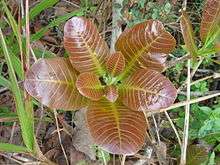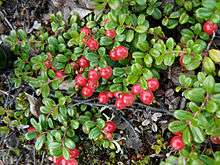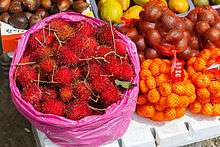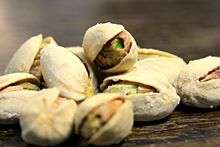Fruits and vegetables
In today's globalized market, so many fruits and vegetables are transported and consumed worldwide that it is easy to forget that it is difficult or impossible to taste quite a lot of things, or at least good examples of them, unless you go where they are growing. Some fruits and vegetables only grow wild and must be gathered on the spot. A good example is Rhodomyrtus tomentosa, sometimes called rose myrtle in English and known as kemunting in Malaysia — a bush that grows wild, and in season, produces uniquely delicious little red or purple berries. You probably won't be able to buy rose myrtle berries in stores or at markets; instead, you may need to know where to find the bushes and be there at the right time to gather some berries before the birds eat them all.
_5.jpg)
Cashew trees, on the other hand, are cultivated, but in order to eat the young leaves, you are really best off picking them off a tree yourself (with permission from the owner), because once picked, they deteriorate very quickly and are therefore impossible to export from cashew-growing regions and quite sub-optimal even when bought in markets in the region. The mangosteen is a delicious fruit native to and cultivated in Southeast Asia. Mangosteens are exported overseas, sometimes in fairly good condition, but they are smaller and not nearly as juicy as the ones you can get easily at markets in their part of the world.
And then there is the banana. Even if you've never been to a banana-growing region, you probably think you know what bananas are like. However, the bananas you are likely to get in temperate zones were removed from the tree way before they were ripe, in order not to have rotted by the time they arrived in your local supermarket. And once they got there, they were probably in one or two varieties at most and perhaps a bit mealy. Even if you think you don't like bananas you've gotten in temperate zones and even if they upset your stomach, consider trying some that were picked off the tree when fully ripe and delivered to market the next day. You'll find them in several varieties, with some tartness as well as sweetness, no mealiness whatsoever, a wonderful taste, and they may settle your stomach.
Understand

| “ | I give you every seed-bearing plant on the face of the whole earth and every tree that has fruit with seed in it. They will be yours for food. | ” |
—Bible, Book of Genesis 1:29 | ||
The terms fruit and vegetable can be differently defined. In science, a vegetable can be any part of a plant, and a fruit is a plant part containing seeds. Fungi are an independent biological kingdom (closer to animals than plants) but count as vegetables in many cuisines.
In a culinary context, savoury ingredients are usually called vegetables, while ingredients with sweet taste count as fruit. Ingredients such as avocado can be both.
Categories
There are many ways to categorize fruits and vegetables, including by biological relationship, plant form, plant part, geographic region or taste. These are used interchangeably.
Citrus

Citrus fruits are available in countless varieties. While they have their origin in Southeast Asia, they are today grown in all subtropical regions, such as southern United States, the Mediterranean, and South Africa. They were popularized in the Royal Navy in the 19th century to fight off scurvy.
Yuzu is popular in Japan and has a wonderful, slightly perfumy flavor something like a lime or kumquat but different from both. The limes available in equatorial countries such as Thailand and Malaysia are even more fragrant than ordinary limes that you can get in supermarkets in temperate countries.
Meyer lemons are widely praised for the taste of both their flesh and zest. They are native to China but their trees were grown mostly for their beauty. They are now widely grown and used for food or as a garnish in many dishes and drinks.
Temperate forest berries

Bilberries, lingonberries, cloudberries and cranberries are among the few fruits available in boreal climates, and common in Nordic cuisine. Other berries, including strawberries, raspberries, blackberries and blueberries, grow wild on hillsides and other temperate areas. The wild berries are the tastiest kinds, packing a lot of flavor in a very small package, as wild strawberries, for example, are much smaller than some cultivated varieties.
Subtropical fruits

In Guangdong province of China and some other areas where they are grown, try lychees. They are exported long distances nowadays but taste best close to where they are grown. They have a unique sweet, perfumy taste with sometimes just a hint of tartness. The best ones usually have red skins, but a bit of brown in the skin is not necessarily a problem, if you don't wait too long to eat them.
The Big Island of Hawaii has some unique fruits which do not grow anywhere else. In particular, poha berries are plentiful there and have a uniquely delicious taste.
When you are in California, especially Central or Southern California, make sure to try some ripe avocados. Outside of avocado-growing areas, you may struggle to find avocados that are ripe and of good quality. Mexico is also known for avocados, which are native to the country. Guacamole, a sauce based on avocados, is a well-known staple of Mexican food, dating back to Aztec times. The avocado is the fattiest fruit in the world except for the durian, but the types of fat in avocados are healthy for most people. Though avocados are biologically fruits and a good one has some sweetness, they can also be treated as vegetables and are frequently used in salads.
Temperate vegetables
Umbria is known for its black truffles, which are used with both pastas and meats. Wild mushrooms are gathered in many places. For example, Poland, Germany (such as the Black Forest of Bavaria) and neighboring countries are famous for their wild boletus and chanterelle mushrooms. In Germany, chanterelles are called Pfifferlinge. Look for dishes and soups with them in season, when they are widely available and not very expensive.
Poland, Russia and other countries in the region also traditionally use sheep sorrel, a tangy, tart leaf used in schav, a soup or drink to which sour cream is traditionally added.
Japanese people greatly appreciate seaweeds. In particular, Okinawans have traditionally eaten a great deal of seaweed of various types, with different tastes and textures.
Okra is appreciated in various parts of the world. In Louisiana, it is often used as a thickening agent in gumbo, a spicy soup central to Cajun cuisine. By contrast, in India and Japan, it is pan-fried or broiled, so as to deemphasize its mucilaginous qualities.
Satsuma-imo, also called Japanese sweet potato, is a delicious tuber that is widely enjoyed throughout Japan. Its taste is not as sweet as orange sweet potatoes, but it is also available in candied form. Good, inexpensive candied satsuma-imo can be found at 7-Eleven stores throughout the country, and more delicious, higher-class candied satsuma-imo can be purchased at food courts in the basements of upscale department stores in neighborhoods like Tokyo's Ginza.
The temperate Altiplano of Andean countries like Peru and Bolivia is the wellspring of the potato, which is found in that part of the world in many varieties and colors. Many of the local types of potato are very nutritious.
Tropical fruits

In Southeast Asia, try mangosteen, rambutan, durian (only for the fearless, as it is very smelly), jambu air, carambola, and if you are lucky enough to find it growing wild, buah kemunting (rose myrtle berries, which are small red or purple fruits that grow on a bush). Also have local bananas, which are ripened on the tree and are really entirely different in taste and texture from the varieties that are picked weeks before tree-ripening for export to temperate countries.
In South America, Hawaii and elsewhere, try passionfruit (called lilikoi in Hawaii).
Tropical vegetables
Water spinach, also called kangkung or ong choy, is popular throughout Southern China and Southeast Asia. It is something like broccoli and something like spinach, but different from both.
In Malaysia, the young leaves of the cashew tree are eaten. They have a unique, tangy taste but deteriorate very quickly after picking, so they are best eaten right away, such as in salad (ulam in Malay — which is eaten with sambal belacan, a combination of shrimp paste and hot pepper) and cannot be exported.
Nuts

The coconut is a staple of the tropics around the world, but this sweet, watery nut is highly atypical of nuts.
In Hawaii, make sure to eat macadamia nuts. Even the big brands like Blue Diamond and Dole sell a much better class of macadamia nuts in Hawaii than you can get anywhere else. Fresh macadamia nuts are wonderfully complex and delicious, and most of the flavors don't seem to survive long trips from Hawaii to any other place.
Syria, Iran and Turkey (Southeastern Anatolia in particular) are famous for their great pistachios. Sadly, Syria is not going to be a safe place to travel to any time soon, but the other two countries are open for visitors.
While peanuts aren't nuts in the botanical sense, they have been grouped here because common parlance assumes them to be nuts. The peanut plant has been grown for thousands of years in Peru, and peanuts form a part of Peruvian cuisine, but the continent where their presence in cuisine is probably most strongly felt is Africa. In West Africa, peanut sauce, peanut butter soup and meat stew with peanuts are frequently found, and East Africans use both peanut sauce and peanut relishes. The peanut is also used to make the spicy peanut sauce in Southeast Asia which is used for satay, a meat-on-skewers dish popular throughout the region; gado-gado, an Indonesian salad; and various other dishes.
See also
- Alcoholic beverages are with few exceptions (such as mead, which is made from honey, or milk- or blood-based drinks) made from fruit or vegetable ingredients
- Foraging
- Travel as a vegetarian